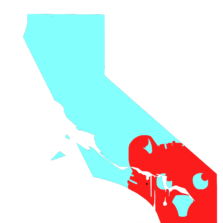

Earthquakes are a common phenomenon most Bay Area residents are familiar with. As the threat of a future earthquake inches closer, it becomes more important to prepare and understand the risks that earthquakes pose.
“Faults are the boundaries between pieces of earth that move at different speeds or different rates,” said biology teacher Richard Whitmarsh.
Faults are located all around the world, including in the Bay Area. There are seven major local hazardous fault lines, the most prominent ones being the San Andreas Fault and the Hayward Fault.
“When the chunks of earth slip past each other along what’s called a fault, that’s when … [built up] energy is released, and that energy being released ripples through the earth,” Whitmarsh said. “That’s an earthquake.”
The San Andreas Fault, one of the largest faults in the world and the fault that has caused most Bay Area earthquakes, is located between the North American and Pacific tectonic plates and runs for more than 745 miles. This fault has a sizable history of causing damaging earthquakes. Possibly the most famous example of its destructive ability is the earthquake of 1906. Biology and AP Environmental Science teacher Greg Moretti has a personal connection to the event.
“My great grandfather was a firefighter … so he fought the fires after the 1906 earthquake”
“I’m a fourth-generation San Francisco born … and my great grandparents were living in San Francisco during the 1906 earthquake,” Moretti said. “My great grandfather was a firefighter in San Francisco during that time so he fought the fires after the earthquake.”
The 1906 earthquake stretched across more than 290 miles of California’s coast.
“[The 1906 earthquake] was a 7.8 [on the earthquake scale],” Moretti said.
This earthquake and the Loma Prieta earthquake of 1989 led to updated building codes and the necessary rebuilding of several key structures including the Bay Bridge. The Aragon gymnasium and other large buildings on campus are examples of structures built according to updated codes.
“Outside of the small gym, there’s these … big angled iron beams that go at like 45 degrees … and those are actually seismic safety features,” Whitmarsh said. “[They ensure] that the gym and big buildings like that are able to flex … but not fall down.”
The San Andreas Fault has also caused several small earthquakes.
“I have experienced small earthquakes but you don’t really notice them that much,” said senior Ella Klein. “I usually sleep through them.”
“When the chunks of Earth slip past each other along … [built up] energy is released”
Smaller earthquakes cause disruptions like shaking windows and furniture.
“I [have] felt many earthquakes like 2.0,” said freshman Phoebe Taylor.
As time goes on, the threat of a larger earthquake grows increasingly imminent.
“What they actually seem to be more worried about … in the … future is a bigger earthquake on the Southern portion of the San Andreas Fault … or on the Hayward fault,” Moretti said. “[The U.S. Geological survey] said we’re likely to get something larger than a 6.7 [on the logarithmic scale] in the Bay Area before 2032.”
Though these predictions may seem daunting, there are many recommended ways to prepare for earthquakes. For example, Moretti uses an innovative new app called Quake Alert, run by the U.S. Geological Survey.
“It works anywhere in California,” Moretti said. “Theoretically, if an earthquake hits, [the app] will give you maybe … 30 seconds of warning which might be enough to … get somewhere safe or get out of a building.”
“You need to be personally prepared, not just generally prepared”
Other ways of preparing for earthquakes include mapping out an evacuation plan and building earthquake and emergency supply kits that contain tools, food and water. Finally, keeping up with current events relating to earthquakes and natural disaster safety can help.
“You need to be personally prepared, not just generally prepared,” Whitmarsh said. “This means preparing for your individual medical needs, along with everything else.”
Taylor and Klein’s families have already prepared emergency packs.
“We have a big box full of non-perishable food and bottled water and flashlights and those aluminum foil blankets,” Taylor said.
The Bay Area, home to the highest density of active fault lines out of any urban area in the U.S., has also been preparing for earthquakes. California laws require homeowners to improve specific aspects of houses built before 1960 that may be unsafe during an earthquake. Newer building codes, including the ones several Aragon buildings have been constructed to follow, have been put in place to make structures more shake-proof. These regulations are designed to help current buildings and structures withstand earthquakes and provide people with an increased level of safety.




